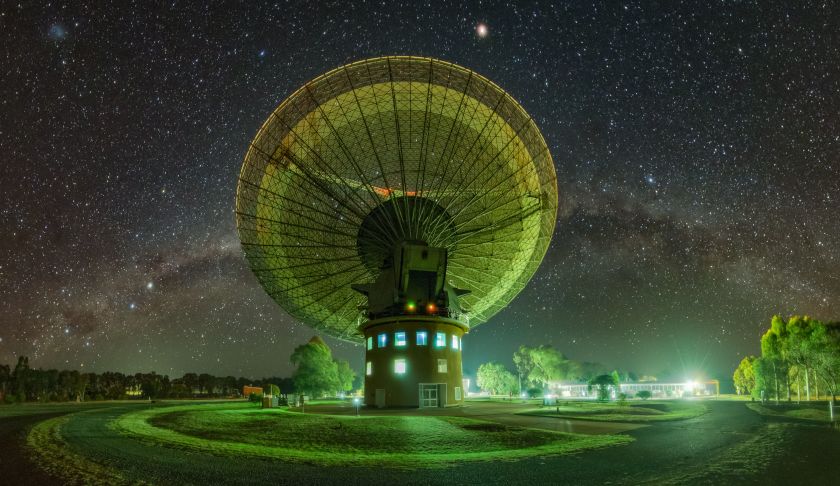
The 64-metre telescope is located on Wiradjuri country in central west NSW, approximately 380 kilometres west of Sydney. The Parkes Radio Telescope received the name Murriyang, which represents the ‘Skyworld’ where a prominent creator spirit of the Wiradjuri Dreaming, Biyaami (Baiame), lives.
Two smaller telescopes at CSIRO’s Parkes Observatory also received Wiradjuri names, Wiradjuri Elder Rhonda Towney conducted the naming ceremony, and Elder Dr Stan Grant AM revealed the telescope’s Wiradjuri names.
Dr Grant said the ceremony was a very proud day for the Wiradjuri people, "This is something that has been coming for a very long time. The naming of the telescopes is one of the biggest things to happen to our people."
As Australia’s national science agency, CSIRO is committed to building genuine partnerships with Aboriginal and Torres Strait Islander peoples through education, science, innovation and research, and demonstrates this commitment by fostering a culture that respects and honours the rich history of the nation.
Over two years, CSIRO’s local Parkes staff worked in collaboration with Wiradjuri Elders, the NSW Aboriginal Education Consultative Group and the North West Wiradjuri Language & Culture NEST on the telescope naming project.
CSIRO chief executive Dr Larry Marshall said Australia had a rich heritage of exploring the world and the stars, and it’s humbling to link our early steps to connect to the universe with that ancient wisdom.
Dr Marshall said, "Science is the search for truth, often we think we are the first to discover it, but much of the knowledge we seek was discovered long before us. We’re honoured that the Wiradjuri Elders have given traditional names to our telescopes at Parkes, to connect them with the oldest scientific tradition in the world."
Wiradjuri Elder and representative of the NSW Aboriginal Education Consultative Group David Towney said language was "everything about who and what we are".
"We teach language to understand country, culture and sky stories. Connecting our language to the telescope is connecting the telescope to country, and commemorating this during NAIDOC week is a way for people to come together and celebrate Wiradjuri culture," Towney said.
Executive manager of CSIRO’s Office of Indigenous Engagement Louisa Warren said giving the telescopes traditional names acknowledges and pays respect to the astronomical knowledge of Aboriginal and Torres Strait Islander peoples.
The Wiradjuri names for the Parkes Radio Telescope cluster, are:
- Murriyang: For the 64-metre Parkes radio telescope - In the Wiradjuri Dreaming, Biyaami (Baiame) is a prominent creator spirit and is represented in the sky by the stars, which also portray the Orion constellation. Murriyang represents the ‘Skyworld’ where Biyaami lives.
- Giyalung Miil: For the 12-metre ASKAP testing antenna - Meaning ‘Smart Eye’, this telescope was commissioned in 2008 as a testbed for a special new type of receiver technology (phased array feed, PAF) used on CSIRO’s Australian Square Kilometre Array Pathfinder (ASKAP) antennas. The PAF is able see different parts of the sky simultaneously, making it a ‘smart eye’.
- Giyalung Guluman: For the 18-metre decommissioned antenna - Meaning ‘Smart Dish’ this antenna had the ability to move along a railway track while observing, and when linked to the main 64-metre antenna became pivotal in early work that determined the size and brightness of radio sources in the sky. The antenna was originally assembled at the CSIRO Fleurs Radio Telescope site, Penrith NSW in 1960, was transported to Parkes in 1963 and became operational in 1965.
"Naming the telescopes is an example of our Reconciliation Action Plan in action. The plan affirms our commitment to reconciliation with Aboriginal and Torres Strait Islander peoples, the oldest living culture in the world, It recognises Aboriginal and Torres Strait Islander peoples as the first people of Australia and respects their enduring connection to lands, skies, waters, plants and animals," Warren explained.
Receive the latest developments and updates on Australia’s space industry direct to your inbox. Subscribe today to Space Connect here.









